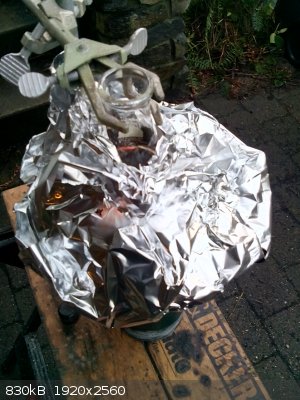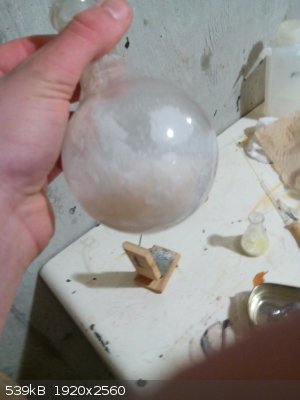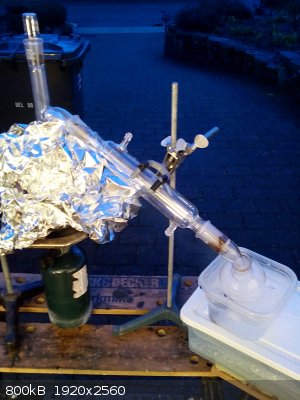Great
Harmless

Posts: 34
Registered: 8-2-2016
Member Is Offline
Mood: No Mood
|
|
Sulfur Trioxide by m-Phosphoric Acid route (success)
Here are some results. I prepared Sulfur Trioxide by reacting Sulfuric acid with meta Phosphoric acid.
The m Phosphoric acid was prepared by heating Phosphoric acid in a flask until all water had boiled off, and another 30 minutes until it had been
reduced to its meta form.
The second half was done insulated with foil. Next, the 40ml of crude meta Phosphoric acid was mixed with 30ml 98% Sulfuric acid. Then, the Sulfur
Trioxide was distilled for one hour, giving a white solid.
The fumes produced during distillation blew my mind. Also, the Phosphoric acid would attack the glass like a mofo, causing about 1 quarter teaspoon of
white precipitate from the glass to form.
  
[Edited on 20-2-2016 by Great]
|
|
|
Marvin
National Hazard
   
Posts: 995
Registered: 13-10-2002
Member Is Offline
Mood: No Mood
|
|
I'm a little surprised no one else has replied yet. This is a tremendous short cut if it works.
I've made metaphosphoric acid and destroyed a lot of pyrex test tubes in the process. I did hold some hope that it would effect amide dehydration and
some of the other reactions we normally need the oxide for, but that's a step beyond.
Some more information about the method would be helpful, what did you do the distillation with? How did you test the product? Were you able to
estimate the yield?
|
|
|
Great
Harmless

Posts: 34
Registered: 8-2-2016
Member Is Offline
Mood: No Mood
|
|
I did the distillation with a 500ml Pyrex RBF, two way adapter, 200mm leibig condenser, and drip adapter, all 24 40. The receiving flask was in an ice
bath.
I tested the product by adding water, the product would make crackling sounds and heat up. I also noticed how much it fumed.
The yield was about 40% judging by the amount of Sulfur Trioxide obtained compared to the amount of Sulfuric Acid starting material.
My starting Phosphoric Acid was 85%.
Thanks for the reply man, I was worried that I broke some sort of unspoken rule. Given by the amount of people who want Thionyl Chloride and TNT, I
thought this would be a big help.
|
|
|
Fulmen
International Hazard
    
Posts: 1748
Registered: 24-9-2005
Member Is Offline
Mood: Bored
|
|
It's not new to the forum BTW, I found several threads discussing it through google. Nevertheless, interesting results. BTW, do you have any opinions
on the reasons for the low yield? I haven't done the math, both SO3 losses and incomplete dehydration of H2SO4 are likely. Could you do a
test/analysis of SO4 in the spent phosphoric acid?
We're not banging rocks together here. We know how to put a man back together.
|
|
|
ave369
Eastern European Lady of Mad Science
   
Posts: 596
Registered: 8-7-2015
Location: No Location
Member Is Offline
Mood: No Mood
|
|
Wow. Just wow. We have a winner, my friends! Such an easy way to prepare SO3 and oleum, which only requires sacrificial flasks, but no monstruous
heating unlike the bisulfate/pyrosulfate method!
Smells like ammonia....
|
|
|
woelen
Super Administrator
        
Posts: 8082
Registered: 20-8-2005
Location: Netherlands
Member Is Offline
Mood: interested
|
|
How safe is this method? You say the glass erlenmeyer is eaten bij de phosphoric acid. This is a scary idea to me. Do you have any idea about the
chance of cracking the hot erlenmeyer with the sulphuric acid and metaphosphoric acid? I must not think of this happening in my lab and then have lots
of super hot heavily fuming H2SO4/HPO3 mix in my lab.
|
|
|
Fulmen
International Hazard
    
Posts: 1748
Registered: 24-9-2005
Member Is Offline
Mood: Bored
|
|
Stainless steel might be a suitable option. "Corrosion Guide" By E. Rabald lists the corrosion rate for 316 at 232-252°C (117% H3PO4) to 4,5mm/year. This equates into .5um per hour.
As I understand it SO3 does not readily attack stainless either, but of course the combination of SO3, H2SO4 and metaphosphoric acid could be an
entirely different beast.
We're not banging rocks together here. We know how to put a man back together.
|
|
|
ave369
Eastern European Lady of Mad Science
   
Posts: 596
Registered: 8-7-2015
Location: No Location
Member Is Offline
Mood: No Mood
|
|
woelen, I think the foil prevents sprinkling of acids around the lab in case of flask failure. They just pour down, and this can be stopped by a box
filled with bicarbonate of soda under the apparatus.
[Edited on 22-2-2016 by ave369]
Smells like ammonia....
|
|
|
byko3y
National Hazard
   
Posts: 721
Registered: 16-3-2015
Member Is Offline
Mood: dooM
|
|
Marvin, it really works, if you have a lot of disposable flasks.
Fulmen, kitchenware made of 316 steel costs a lot. In fact, there's reactors made of alloy 20, which is even more resistant to
corrosion, than 316 SS. But instead you can use something as simple and cheap as hard porcelain, which has the corrosion rate similar to that of 316
steel. Temperature higher than 300°C is needed to prepare metaphosphoric acid, and i'm sure corrosion rate of 316 SS will be somewhere at 20 mm/yeah
for these conditions, while quartz flask corrosion rate in this case is 45 mm/year. Corrosion Handbook - B8 Enamel - Phosphoric Acid - B. Non-metallic inorganic materials
250 ml flask weights like 150-200 g, so something like 30 g of glass need to be eaten before the flask becomes dangerous to use. Quater of teaspoon is
something like 1-2 g of silicate-phosphate mixture, so you can perform a dozen of evaporations until the flask becomes fragile.
The problem is that metaphosphoric acid is solid at room temperature, so eitehr you need to add sulfuric acid to this flask and the flask should have
joints, or you should remove the solid from the porcelain device. BTW, some companies sell flasks with reeeally think walls, which can withstand
concentrated phosphoric acid at 300°C for days and weeks.
ave369, I don't recomend using carbonates for pouring phosphoric acid into, because your phosphoric acid will be splattered all over
the place.
PS: I forgot I have a precise data for the etch rate of soda-lime glass at 300°C and 400°C: 11-32 µm/hour (micrometer per hour, lower value for low
polymerization state, higher - for almost complete polymerization at this temperature) at 300°C; 19-82 µm/hour for 400°C. 2-3 hours are required to
complete the dehydration. The action of phosphoric acid on glass
[Edited on 22-2-2016 by byko3y]
|
|
|
Great
Harmless

Posts: 34
Registered: 8-2-2016
Member Is Offline
Mood: No Mood
|
|
Steel will just dissolve because this was heated to red heat. my low yields were because I removed the Phosphoric Acid from heating before all had
been converted to meta form.
The corrosion of the glass, which was my biggest concern, was not a huge problem. I could likely do the reaction again many more times with the same
flask.
I poured the meta phosphoric acid directly into a 500ml of Sulfuric Acid, and connected it to the distillation setup.
[Edited on 22-2-2016 by Great]

[Edited on 22-2-2016 by Great]
|
|
|
byko3y
National Hazard
   
Posts: 721
Registered: 16-3-2015
Member Is Offline
Mood: dooM
|
|
Great, I think what you've used is in fact polyphosphoric acid, because metaphosphoric acid has melting point of 200-250°C, so you
can't pour it in meta-Phosphoric acid
|
|
|
Great
Harmless

Posts: 34
Registered: 8-2-2016
Member Is Offline
Mood: No Mood
|
|
It was poured while still hot, because I've heard of it solidifying and becoming hard to remove.
|
|
|
BromicAcid
International Hazard
    
Posts: 3266
Registered: 13-7-2003
Location: Wisconsin
Member Is Offline
Mood: Rock n' Roll
|
|
Although by a different route, there is plenty of practical information on the high-temperature distillation of sulfur trioxide in Garage Chemist's
pre-publication on Sulfur Trioxide preparation:
http://www.sciencemadness.org/member_publications/SO3_and_ol...
With respect to metaphosphoric acid I find it prudent to link back to the thread that kicked off the rush of interest in the subject back in 2005:
http://www.sciencemadness.org/talk/viewthread.php?tid=4409
Note that to make the metaphosphoric acid several different crucible materials were trialed, personally I had success using a 2" copper end cap (for
piping) that I purchased from the local hardware store.
Of course what is old is new again with this thread. Although interesting, this method of preparation has been carried out by other members
successfully in the past, check out this nugget, also from Garage Chemist (note that this is also from 2005), note the excitement and how sad it is
that this has to be 'rediscovered':
http://www.sciencemadness.org/talk/viewthread.php?tid=727&am...
| Quote: | Ladies and Gentlemen! An important breakthrough in the realm of amateur chemistry has been made right in the last few minutes!
I am very pleased to tell you that the highly useful chemical OLEUM in every desired SO3 concentration can now be mass-produced in every
garage/basement laboratory. The apparatus is a simple distillation setup with ground- glass joints.
Credits go to CD-ROM-LAUFWERK for having made the discovery that Metaphosphoric Acid is able to dehydrate conc. Sulfuric Acid to Sulphur Trioxide in
high yields.
My last experiment was the following:
13,5ml (0,2mol) 85% Phosphoric Acid were heated in a 100ml beaker until boiling. When the boiling subsided, the heat was turned on maximum until the
bottom part of the beaker was glowing faintly red. This was continued for 5 minutes.
The resulting liquid (HPO3)n was allowed to cool covered for a short time, but only to the point where it was still pourable (use gloves, it's really
hot!).
It was poured into a dried 100ml round- bottom flask and quickly stoppered.
The beaker was attacked somewhat by the hot (HPO3)n and had a frosted appearance after the (HPO3)n residues had been washed out. However, the frosted
appearance could be removed by boiling some NaOH solution in this beaker.
An iron crucible is useless, it gets dissolved rapidly.
To the (HPO3)n in the flask was added 4ml of conc. H2SO4 (a bit less than 0,1mol).
Then the flask was fitted with a dried NS 14,5/23 distillation bridge WITHOUT running cooling water through the condenser (otherwise the SO3 will
solidify in there and clog it). The condenser had a length of 160mm. The receiver was immersed in ice water in order for the SO3 to condense there and
not in the condenser.
The mixture was heated with a bunsen burner.
After some heating and swirling, the (HPO3)n mixed completely with the H2SO4.
Then the heating was put on maximum.
The liquid very soon started boiling and a colorless liquid began distilling at about 40- 60°C steam temperature. A lot of heat is needed in order to
effect the complete reaction between (HPO3)n and H2SO4. About 1,5-2ml collected in the receiver.
The distillate, on pouring it into a beaker, fumed incredibly strong and emitted so much smoke that I had to turn my fume hood on maximum power. The
exhaust pipe outside of my lab emitted a stream of white smoke which filled the garden.
As the liquid contacted some moisture in the beaker, a loud crackling noise was observed and the beaker erupted even more of the thick white smoke.
You have to see it to believe how much a liquid can fume in air. It's a real spectacle.
This liquid is definately oleum of a very high concentration, if not pure sulphur trioxide.
Redistilling the liquid will yield pure SO3 in liquid form.
The residue from the distillation can again be turned into (HPO3)n by heating to red heat. It can be reused indefinately for dehydrating H2SO4 to SO3.
|
|
|
|
Great
Harmless

Posts: 34
Registered: 8-2-2016
Member Is Offline
Mood: No Mood
|
|
I can literally confirm everything that guy says. Thanks for bringing it up man, there are tons of old but golden threads like that one hidden away.
|
|
|
Fulmen
International Hazard
    
Posts: 1748
Registered: 24-9-2005
Member Is Offline
Mood: Bored
|
|
Question is whether one can turn this into a convenient process for making slightly larger amounts. What temperatures are involved at each step?
Could you distill off the SO3 by adding H2SO4 to the already warm poly/meta?
We're not banging rocks together here. We know how to put a man back together.
|
|
|
ave369
Eastern European Lady of Mad Science
   
Posts: 596
Registered: 8-7-2015
Location: No Location
Member Is Offline
Mood: No Mood
|
|
Quote: Originally posted by BromicAcid  |
Then the flask was fitted with a dried NS 14,5/23 distillation bridge WITHOUT running cooling water through the condenser (otherwise the SO3 will
solidify in there and clog it).
|
I think a retort would be a correct vessel for this reaction. If we are using air-cooling and receiver cooling anyway, there is no point in using
modern condensers.
Smells like ammonia....
|
|
|
Magpie
lab constructor
    
Posts: 5939
Registered: 1-11-2003
Location: USA
Member Is Offline
Mood: Chemistry: the subtle science.
|
|
The chemistry of this method for making SO3 is very interesting and I'm in no way trying to discourage its further development. But, garage chemist
was very familiar with this method as the huge SO3 thread shows, yet he elected to present two other methods in Prepublication. That speaks volumes
to me. 
The single most important condition for a successful synthesis is good mixing - Nicodem
|
|
|